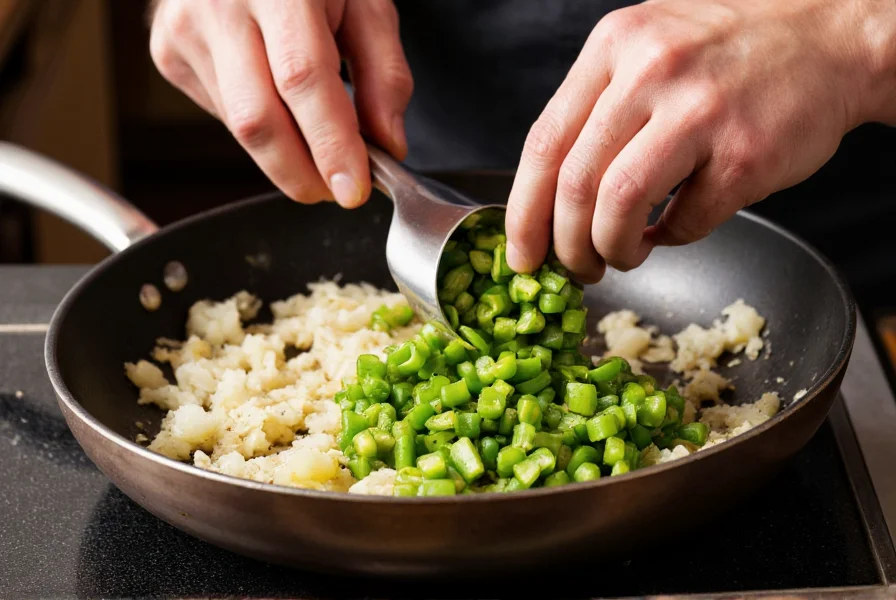Canned green chili peppers provide home cooks with reliable access to this essential Southwestern ingredient year-round. Unlike fresh chilies that vary in heat and availability, canned versions deliver consistent flavor and texture perfect for incorporating into everyday meals. Understanding how to select, use, and store these versatile ingredients transforms ordinary dishes into restaurant-quality creations.
What Exactly Are Canned Green Chili Peppers?
Canned green chili peppers consist primarily of roasted and peeled mild chili varieties, most commonly Anaheim or New Mexico chilies. The canning process involves roasting the peppers over open flames, removing the skins, and sealing them in liquid with citric acid to preserve color and flavor. This method maintains the distinctive smoky-sweet profile while eliminating the inconsistency of fresh peppers.
When examining a can of green chili peppers, you'll typically find these ingredients:
| Ingredient | Purpose | Typical Percentage |
|---|---|---|
| Green chili peppers | Main ingredient | 85-90% |
| Water | Preservation medium | 8-12% |
| Citric acid | Preservative and color maintainer | 0.5-1% |
| Salt | Flavor enhancer (optional) | 0-0.5% |
Understanding Varieties and Labels
When selecting a can of green chili peppers, understanding label terminology prevents recipe disappointment. The market offers several distinct options:
- Mild vs. Hot: Mild varieties contain minimal seeds and membranes, while hot versions include more of these heat-concentrated parts
- Whole vs. Diced: Whole peppers maintain texture in dishes, while diced integrates more thoroughly
- Organic vs. Conventional: Organic options avoid pesticides but show minimal flavor differences
- Regional Varieties: New Mexico chilies offer earthier notes, while California-grown tend toward sweetness
Reading labels carefully helps identify products containing unwanted additives. Premium brands typically list only peppers, water, and citric acid, while lower-quality options may include calcium chloride (for firmness) or excessive salt.

Nutritional Profile and Shelf Life
Canned green chili peppers retain significant nutritional value despite processing. A standard 2.5-ounce serving provides:
- Approximately 15 calories
- 1 gram of dietary fiber
- 60% of daily vitamin C requirements
- Notable vitamin A and potassium content
- Negligible fat and protein
Properly stored in a cool, dry pantry, unopened cans maintain peak quality for 2-5 years. Once opened, transfer unused portions to an airtight container and refrigerate for up to one week. For longer storage, freeze in ice cube trays then transfer to freezer bags for up to six months—ideal for preserving small quantities between uses.
Practical Cooking Applications
Mastering how to use canned green chili peppers elevates numerous dishes. These versatile ingredients work exceptionally well in:
- Enchilada sauces: Blend with broth and spices for authentic base
- Breakfast dishes: Fold into scrambled eggs or breakfast burritos
- Casseroles: Layer in chicken enchilada casseroles or green chili mac
- Soups and stews: Add depth to posole or white bean chili
- Marinades: Combine with citrus and garlic for meats
For optimal flavor integration, sauté canned green chilies in oil for 2-3 minutes before adding other ingredients. This simple step enhances their natural sweetness and reduces any metallic canning taste. When substituting in recipes calling for fresh chilies, use a 1:1 ratio but reduce additional liquid by 25% since canned varieties contain water.

Effective Substitution Strategies
When you need a substitute for canned green chilies, consider these practical alternatives:
- Fresh roasted peppers: Use 4 ounces fresh Anaheim peppers roasted and peeled per can
- Green salsa verde: Substitute 1/2 cup for milder flavor profile
- Green bell peppers: For non-spicy applications, though lacking smokiness
- Homemade version: Roast, peel, and preserve your own during peak season
Understanding the difference between canned green chilies and jalapeños prevents recipe disasters. While both are green peppers, canned green chilies (typically Anaheim) measure 500-2,500 Scoville units, whereas jalapeños range from 2,500-8,000 units. Substituting one for the other dramatically alters heat levels.
Popular Recipes Featuring Canned Green Chili Peppers
Certain dishes showcase canned green chili peppers exceptionally well. Consider these classic applications:
- Green Chili Chicken Enchiladas: Shredded chicken mixed with 2 cans of green chilies, rolled in corn tortillas, topped with cheese and baked
- Southwestern Cornbread: Add 1/2 can to standard cornbread batter for savory depth
- Green Chili Cheeseburger: Mix 1/4 cup into ground beef patties before grilling
- White Bean Green Chili Soup: Combine 2 cans with white beans, broth, and spices for hearty meal
Professional chefs often recommend draining canned green chilies before use unless the recipe specifically calls for the liquid. This simple step prevents dishes from becoming watery while concentrating flavor.
What's the difference between canned green chilies and jalapeños?
Canned green chilies typically use mild Anaheim or New Mexico peppers (500-2,500 Scoville units), while jalapeños are significantly hotter (2,500-8,000 units). Green chilies offer a more vegetal, slightly sweet flavor profile compared to jalapeños' sharper heat.
Can I freeze canned green chili peppers?
Yes, transfer unused portions to an airtight container or ice cube trays, then freeze for up to six months. Thaw in the refrigerator before using in cooked dishes. Note that texture may soften slightly after freezing.
Why does my recipe call for draining canned green chilies?
Draining removes excess liquid that could make dishes watery. The peppers retain sufficient moisture after draining to contribute flavor without diluting sauces or batters. For most applications, draining improves texture and concentrates flavor.
How can I reduce the heat level of canned green chilies?
Rinse drained peppers under cold water to remove surface capsaicin. For significant heat reduction, soak in milk or buttermilk for 15 minutes before use, as dairy proteins neutralize capsaicin better than water.











 浙公网安备
33010002000092号
浙公网安备
33010002000092号 浙B2-20120091-4
浙B2-20120091-4